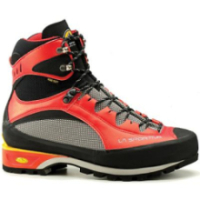|
Is there one mountaineering boot to do it all? The short answer is, well, not really. The problem is that the mountaineering boot you want to climb, say, the Swiss Matterhorn is an entirely different style of boot than you want to climb Denali in Alaska. The Matterhorn is climbed quickly in moderate temperatures and involves a lot of steep rock climbing in addition to some snow and crampon work and for that you need a lightweight mountaineering boot that has some sensitivity for the rock sections but can still take crampons for the upper snow and ice sections. Denali is a cold and high Alaskan peak where the only climbing movement is walking upright on snow and ice. This requires a very warm, highly insulated boot where sensitivity is not a concern. If your goal is to be an all round mountaineer and alpine climber you will need a quiver of mountain boots. Two boots will suffice for most situations, but three boots would cover just about all your bases. A mountain boot would be loosely defined as a climbing boot that has a stiff lug sole for climbing snow and ice and is suitable for use with crampons. Following is a description of three basic mountain boot designs and their uses. The lightweight summer alpine climbing boot This is the nimble boot you use for fast and light summer climbs in the Sierra Nevada of California, The North Cascades of Washington State, The Alps of Europe and any other place where the temps during the day are above freezing but where you may encounter snow and ice in addition to rock sections.
These are stiff leather boots with lug soles and little to no insulation. Most are waterproof with waterproof/breathable linings and they will take a strap-on or semi-automatic crampon without a toe bail. They breath well and are much lighter than other alpine boots which make them great for those long trail approaches and more technical rock sections. However, they just don’t have the insulation you need when the temps get well below freezing. Examples are the La Sportiva Trango GTX, The Scarpa Charmoz GTX and the Garmont Tower GTX, among others. The high altitude double plastic boot This is the big daddy of the mountaineering boot world. They are built for warmth, period. This is a big clunker of a boot that you need for those cold, high altitude climbs in Alaska, the Himalaya and some parts of South America such as Aconcagua. They are also an excellent choice for mid-winter and early spring mountaineering in the lower 48.
They feature a removable liner and plastic or plastic/synthetic leather outer shell. The removable liners are key which allow you to dry them out and keep them warm in a sleeping bag at night. They are highly insulated which can keep your feet warm, but reduces their sensitivity and makes them a poor choice for more technical climbing in warmer temperatures. Some plastic boots are warmer than others and some come with built in overboots for the most extreme high altitude and cold conditions such as the 8000 meter peaks of the Himalaya. Examples would be the La Sportiva Spantik, The Lowa Civetta and the Scarpa inverno, among others. The all rounder The boots above will get you by in most mountaineering situations, but if you really want the full quiver you will want that in-between workhorse boot. These boots are usually leather or synthetic leather, have some insulation for below freezing temps but they manage to keep the weight down for when the terrain gets a little technical. They do not feature a removable liner and many of them come with a built in zippered gaiter. This is boot you want for technical ice climbing in all but the coldest temps, for summer mountaineering on big mountains such as Rainier, Mont Blanc or California’s Mount Shasta.
While you may ask, “why not just go with one pair of all-rounder boots?” Good question. However, when you get on technical rock in warmer temps you may find yourself struggling a bit. The same would be true on a long approach. On the other side of the spectrum, you’re asking for big trouble and perhaps a few missing toes if you try to use these boots on Denali or a 6-8 thousand meter high altitude climb. Examples of these boots are the La Sportiva Nepal EVO, The La Sportiva Batura and the Scarpa Phantom.
There are other alpine climbing footwear choices such as technical rock shoes, low-top sticky rubber approach shoes and even running shoes, but these don’t really fall into the alpine climbing or mountaineering category where crampons may be required. It is not unheard of to approach a climb with mountaineering boots and then switch to your rock shoes for the technical 5th class rock climbing. It is far less common, and not usually a good idea, to approach a colder climb with lightweight footwear and then switch into a heavier boot. You are just carrying all that extra weight with the 2nd pair of footwear. An exception to that would be a long expedition with a trekking approach but usually someone, or something, else is carrying all your gear to basecamp. And finally, fit is a major concern with any footwear. Within these categories whatever fits your foot the best is the right boot for you.
by Dave Miller |









